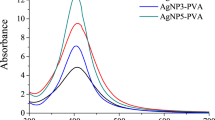Abstract
Acute toxicity of nanoparticles of aluminum oxide (Al2O3) with a size of 13–16 nm was investigated by the biotesting method using Paramecium caudatum ciliates in the concentration range of 10–100 μg/mL. Aluminum oxide has an acute toxic effect on paramecium at concentrations of 20–100 μg/mL. The mean lethal dose (LD50) is equal to the concentration of nanoparticles at which the mortality of ciliates in relation to the control reached 50%. The LD50 for Al2O3 nanoparticles is 23 μg/mL at a 24-h exposure. According to published data, the toxic effect of Al2O3 nanoparticles is specific and depends on the size and surface charge of the particles and on the interfacial interaction of nanoparticles with the cell surface, as well as on the concentration and exposure time.



Similar content being viewed by others
REFERENCES
R. Chatterjee, Environ. Sci. Technol. 2, 339 (2008). https://doi.org/10.1021/eS0870909
J. Gangwar, B. K. Gupta, and A. K. Srivastava, Defense Sci. J. 66, 323 (2016). https://doi.org/10.14429/dsj.66.10206
A. Yu. Godymchuk, G. G. Savel’ev, and A. P. Zykova, Ecology of Nanomaterials, The School-Book (BINOM, Labor. Znanii, Moscow, 2012) [in Russian].
O. A. Zeinalov, S. P. Kombarova, D. V. Bagrov, et al., Obz. Klin. Farmakol. Lek. Ter. 14 (3), 24 (2016). https://doi.org/10.17816/RCF14324-33
N. Roussel, L. Lallemant, J. Y. Chane-Ching, et al., J. Am. Ceram. Soc. 96, 1039 (2013). https://doi.org/10.1111/jace.12255
V. V. Ivanov, A. S. Kaigorodov, V. R. Khrustov, et al., Ross. Nanotekhnol. 1 (1–2), 201 (2006).
A. A. Shumakova, O. N. Tananova, E. A. Arianova, et al., Vopr. Pitan. 81 (6), 54 (2012).
H. Ma, P. L. Williams, and S. A. Diamond, Environ. Pollut. 172, 76 (2013). https://doi.org/10.1016/j.envpol.2012.08.011
Yu. N. Morgalev, I. A. Gosteva, T. G. Morgaleva, S. Yu. Morgalev, E. V. Kostenko, and B. A. Kudryav-tsev, Nanotechnol. Russ. 13, 311 (2018).
E. J. Parka, G. H. Leeb, C. Yoonc, et al., J. Appl. Toxicol. 36, 424 (2016). doi org/https://doi.org/10.1002/jat.3233
A. L. di Virgilio, M. Reigosa, and M. F. de Mele, J. Biomed. Mater. Res. A 92, 80 (2010). https://doi.org/10.1002/jbm.a.32339
E. Radziun, J. Dudkiewicz-Wilczynska, I. Ksiaek, et al., Toxicol. Vitro 25, 1694 (2011).
Z. M. Song, H. Tang, X. Deng, et al., J. Nanosci. Nanotechnol. 17, 2881 (2017). https://doi.org/10.1166/jnn.2017.13056
E. Dong, Y. Wang, S. T. Yang, et al., J. Nanosci. Nanotechnol. 11, 7848 (2011). https://doi.org/10.1166/jnn.2011.4748
I. V. Shugalei, A. V. Garabadzhiu, M. A. Ilyushin, and A. M. Sudarikov, Ekol. Khim. 21, 172 (2012).
A. S. Cardwell, W. J. Adams, R. W. Gensemer, et al., Environ. Toxicol. Chem. 37, 36 (2018). https://doi.org/10.1002/etc.3901
S. Pakrashi, S. Dalai, A. Humayun, et al., PLOS One 8 (9), e74003 (2013). https://doi.org/10.1371/journal.pone.0074003
N. Musee, P. J. Oberholster, L. Sikhwivhilu, and A. M. Botha, Chemosphere 81, 1196 (2010). https://doi.org/10.1016/j.chemosphere.2010.09.040
P. V. Vidya and K. C. Chitra, Int. J. Fisher. Aquat. Stud. 3, 13 (2018).
J. G. Coleman, D. R. Johnson, J. K. Stanley, et al., Environ. Toxicol. Chem. 29, 1575 (2010). https://doi.org/10.1002/etc.196
T. Stadler, M. Buteler, D. K. Weaver, and S. Sofie, J. Stored Prod. Res. 48, 81 (2012). https://doi.org/10.1016/j.jspr.2011.09.004
GOST (State Standard) No. 31674-2012: Feed, compound feed, compound feed raw materials. Methods for determining general toxicity (2012; 2016).
M. Kryuchkova, A. Danilushkina, Y. Lvov, and R. Fakhrullin, Environ. Sci.: Nano 3, 442 (2016). https://doi.org/10.1039/c5en00201j
G. I. Fakhrullina, F. S. Akhatova, Y. M. Lvov, and R. F. Fakhrullin, Environ. Sci.: Nano 2, 54 (2015). https://doi.org/10.1039/C4EN00135D
K. Li, Y. Chen, W. Zhang, et al., Chem. Res. Toxicol. 25, 1675 (2012). https://doi.org/10.1021/tx300151y
I. Gosteva, Yu. Morgalev, T. Morgaleva, and S. Morgalev, IOP Conf. Ser.: Mater. Sci. Eng. 98, 012007 (2015). https://doi.org/10.1088/1757-899X/98/1/012007
M. A. Gatoo, S. Naseem, M. Y. Arfat, et al., BioMed Res. Int. 8, 498420 (2014). https://doi.org/10.1155/2014/498420
N. V. Zaitseva, M. A. Zemlyanova, M. S. Stepankov, and A. M. Ignatova, Ekol. Cheloveka, No. 5, 9 (2018). https://doi.org/10.33396/1728-0869-2018-5-9-15
Funding
This work was supported by a subsidy allocated to the Kazan Federal University for the implementation of state assignment no. 0671-2020-0058 in the field of scientific activity. The work was carried out within the framework of the program for increasing the competitiveness of the Kazan Federal University at the expense of the grant of the President of the Russian Federation (MD-2153.2020.3).
Author information
Authors and Affiliations
Corresponding author
Rights and permissions
About this article
Cite this article
Kryuchkova, M.A., Akhatova, F.S. & Fakhrullin, R.F. The Survival of the Infusoria Paramecium caudatum in the Presence of Aluminum Oxide Nanoparticles. Nanotechnol Russia 16, 532–536 (2021). https://doi.org/10.1134/S2635167621040042
Received:
Revised:
Accepted:
Published:
Issue Date:
DOI: https://doi.org/10.1134/S2635167621040042




